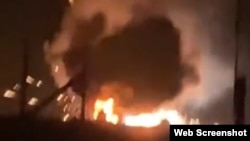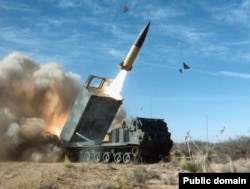The predawn skies over the outskirts of the Ukrainian port of Berdyansk lit up in oranges and reds from fires and explosions at an airfield where Russian Kh-52 and Mi-24 helicopters, used for targeting Ukrainian armor trying to breach Russian lines 120 kilometers to the north, were parked.
Around 18 hours later, the attack, documented in expletive-filled videos published on Telegram, was confirmed to be what Russian war bloggers had suspected: Ukraine used secretly supplied U.S. long-range missiles known as ATACMS to target a squadron of attack helicopters, damaging or destroying as many as nine.
It wasn't the only bad news Russia received this week; about 220 kilometers to the northeast, a major offensive aimed at encircling Ukrainian forces in the industrial city of Avdiyivka was on the verge of faltering, or at least progressing far more slowly than commanders likely had anticipated.
Now in its 20th month, Russia's invasion of Ukraine is approaching its second winter, shifting again into a new phase with no clear indication that either side has the upper hand.
Whether the Avdiyivka offensive or the Ukrainian surprise strike at Berdyansk or a reported Dnieper River crossing by Ukrainian marine infantry will change things is an open question.
What Happened At Berdyansk?
For more than a year, Ukrainian officials have been begging the United States -- which has sent more than $62 billion in weaponry and other military equipment -- to supply precision, long-range missiles known as Army Tactical Missile System.
The missiles, known as ATACMS and better known by the shorthand pronounced "attack 'ems," are a long-range weapon, fired from another U.S.-supplied weapon: the multiple rocket-launch system known as HIMARS. Costing around $1.5 million apiece, ATACMS have a range of up to 520 kilometers, which enables Ukraine to hit targets deep behind Russian lines.
U.S. officials were reluctant to send them, however, fearing Russia would view the move as escalatory.
In late August, U.S. news reports said the White House had finally approved delivery of the missiles. Neither the White House nor the Pentagon ever confirmed delivery of the missiles.
Sometime after midnight on October 17, a series of explosions erupted at the Russian-controlled Berdyansk airfield. Among several videos posted to Telegram, one purported to show antiaircraft defenses firing above an airfield; another includes a profanity-filled Russian rant that specifically mentions the helicopters based at the field.
There's no way to verify the videos, and as of midafternoon on October 18, no evidence had emerged to indicate how many helicopters had been hit.
But the information about the attack itself was later corroborated in part by posts by Russian bloggers, and announcements by Ukrainian officials, who claimed that nine Russian helicopters were damaged or destroyed. Other images later posted to Telegram appeared to show U.S.-supplied cluster-type munitions that would be delivered, a variation of the ATACMS missile that has a shorter range.
Russia's Defense Ministry has made no comment on the attack.
The extent to which the arrival of ATACMS missiles will change the battlefield is unclear. At the very least, experts say, Russia will be forced to move its helicopters or ammunition depots or field headquarters much further away from the front lines.
The ATACMS "will likely prompt the Russian command to disperse aviation assets and withdraw some aircraft to airfields further from the front line," the Washington-based Institute for the Study of War said on October 17. The missiles also pose "a significant threat to Russian ammunition depots in rear areas and will likely force the Russian command to choose between fortifying existing depots or further dispersing depots throughout occupied Ukraine."
Resupplying, or rotating, troops fighting in grueling trench warfare will be more difficult and take longer. Russia has been able to use attack helicopters to great effect; flying low to avoid air defenses, then popping up above tree lines, firing precision tank-killing missiles, then escaping antiaircraft missiles.
Still, if the Ukrainian estimate for the number of helicopters damaged or destroyed at Berdyansk is correct, it would be one of the biggest aviation losses for Russia since the start of the invasion.
A River Runs Through It
Last year, Ukrainian forces pulled off two significant battlefield advances. One, in the northeastern Kharkiv region, surprised Russian troops there, forcing them to withdraw to a line east of the Oskil River, a north-south waterway and natural defense.
To the southwest, Ukrainian troops pummeled Russian paratroopers and other units on the western banks of the Dnieper River, ultimately forcing them to withdraw across the river.
Since then, Russia has continued to pound cities and towns across the river with artillery and missiles. In June, a Dnieper River dam under Russian control at Nova Kakhovka was destroyed under not-fully-clear circumstances, flooding thousands of hectares downstream and causing widespread damage.
In the time since Russia's Kherson withdrawal, Ukrainian special forces and reconnaissance units have made repeated forays across the river and further downstream at the river's mouth, the Dniprovska Gulf.
Early on October 18, two closely watched Russian war bloggers reported that troops from Ukraine's 35th and 36th Marine Infantry Brigades had crossed the Dnieper, about 8 kilometers upriver from the now-destroyed Antonivskiy Bridge, in Kherson city. One report said units reached the village of Pishchanivka, about 2 kilometers southeast of the riverbank.
"The very fact of the presence of Ukraine's armed forces on our shore is not news," one blogger known as Two Majors wrote on October 18. "However, the movement of reconnaissance, electronic warfare, and communications systems to the front line of defense is a clear sign."
Early in the afternoon on October 18, Russia's Defense Ministry appeared to corroborate the reports of a river crossing, saying, "the actions of four sabotage and reconnaissance groups were suppressed in the areas of two settlements adjacent to Pishchanivka."
A few hours later, however, there were reports that Ukrainian forces were still holding off Russian troops outside of the village.
What's Going On At Avdiyivka?
Russia launched a major offensive around the industrial city of Avdiyivka, northwest of Donetsk, on October 10, sending in several thousand troops and a sizable number of armored vehicles in two directions, in another effort to create a "cauldron" to encircle Ukrainian forces.
It's the biggest single concentrated push by Russian forces since at least February, when a large contingent of Russian units was decimated -- as many as 130 tanks and armored vehicles -- near Vuhledar, a town 60 kilometers southwest of Donetsk.
"I can definitely say that this is the largest offensive that has taken place in Avdiyivka throughout the entire war, beginning since 2014," Vitaliy Barabash, the head of the city's military administration, said on October 18.
Ukraine's stubborn hold on Avdiyivka has allowed it to threaten Russian lines to the east, and parts of Donetsk's outskirts; Russia has made several efforts to take it back.
As of October 18, reporting by Ukrainian officials and Russian military bloggers alike has pointed to a slowing tempo by Russian forces in pressing Ukrainian lines, either because Russian losses were too great or for other reasons not clear.
"This is not the end. The enemy is regrouping, and for three nights in a row is pulling equipment deeper to the rear for repairs," Barabash said.
Konrad Muzyka, a Polish-based military analyst, said in a report on October 13 that as many 40 Russian vehicles and other pieces of equipment may have been damaged or destroyed.
"The attack on the city is the epitome of the Russian Ground Forces as an organization, which is inherently unable to adjust, learn from past mistakes, disorganized and where the mission command is heavy-handed, leaving little initiative to junior commanders," Muzyka wrote in an October 13 report.
Breach, But No Breakthrough
In early June, around the same time as the Nova Kakhovka dam collapse, Ukraine launched a major counteroffensive in three locations along the 1,200-kilometer front line that stretches from the Kherson region in the southwest, to the Kharkiv region in the northeast.
The most concentrated effort focused on the southern Zaporizhzhya region, with Ukrainian forces pushing south from the town of Orikhiv, in hopes of reaching the cities of Melitopol and Berdyansk. That would allow Ukraine to cut off the "land bridge" -- the overland road and train routes connecting Crimea to Russia.
That effort, however, ground to a near halt in the opening weeks, as Ukrainian troops encountered formidable, triple-layered Russian defenses dubbed the Surovikin Line, named for the Russian general who ordered their construction.
Ukraine retooled its tactics and in early September, units managed to breach one, possibly two layers of the Surovikin Line, near the towns of Robotyne and Verbove, spurring hopes of a wider breakthrough.
That didn't happen, and Russia redeployed some of its best-trained airborne units to help fortify Russian lines and slow the push by Ukrainian advances.
With the onset of wet autumn weather, then cold winter temperatures, it's unclear how much progress Ukraine will be able to make before spring.














